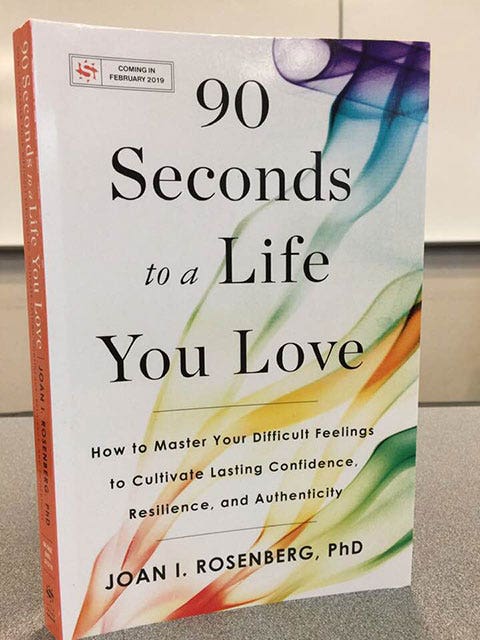Joan Rosenberg Gives You 90 Seconds to a Better You in 2019

Each January, we strive to become a better version of ourselves—one that eats healthier, works out more, drinks less and saves more money.
But when our enthusiasm fades after the first week or so, that’s when the going gets tough and our inner critics pipe up, says Dr. Joan Rosenberg, Ph.D., psychologist, creator of Emotional Mastery Training and author of the forthcoming book “90 Seconds to a Life You Love” (Little, Brown & Co., February 2019).
“We say, ‘I should be further along, so I’m going to quit,’ or ‘I’m so stupid, I can’t pull this off. Why am I such a loser?’ The kinds of things we say and think to ourselves can really hold us back,” she says.
Interestingly enough, we engage in this kind of self-abuse to escape the unpleasant physical sensations that accompany certain difficult feelings, such as the hot flush of shame, the rapid heartbeat and clenched chest of embarrassment, or the heavy feeling in our chest of disappointment. These are the sensations that come up as we progress more slowly than we’d hoped or stumble on the path to our goals, Rosenberg says.
And while some might consider this kind of self-criticism a motivator, it’s actually quite damaging.

Eight feelings we try to avoid

Indeed, for many, it’s this kind of avoidance of physical unpleasantness that makes us embark on resolutions in the first place, as we overeat, drink, binge-watch or compulsively shop just to escape the physical sensations associated with our feelings. When we avoid sensations, Rosenberg says, we go from feeling bad to feeling worse.
According to Rosenberg, the eight most common unpleasant feelings we’re trying to avoid are the following:
- Sadness
- Shame
- Helplessness
- Anger
- Embarrassment
- Disappointment
- Frustration
- Vulnerability
You can’t control these feelings or how often they occur, Rosenberg says. But if we can learn to identify them as they occur and ride out the sensations that accompany them, we gain the resiliency, confidence and authenticity to ultimately build the life we want.
The good news is that riding these waves of unpleasant sensations is a lot easier than you think. They’re usually over, Rosenberg says, before you’ve reached the halfway point in your favorite song.
“If people realized that the biochemical wave that brings it on only lasts 60 to 90 seconds,” Rosenberg says, “most of them would say, ‘Heck, I can do that.’”
90 seconds to shut down self-criticism

- The next time you catch yourself engaging in this kind of name-calling and self-criticism when you slip up, stop and take a step back. Realize that you’re trying to use this negative self-talk to distance yourself from unpleasant feelings.
- Recognize that something painful is trying to make itself known to you.
- Ask yourself, “What is difficult for me to know, feel or bear right now?” Maybe you’re disappointed or sad that you powered through a carton of Ben & Jerry’s or skipped the gym again.
- Take several deep breaths as you ride that 90-second wave of sensation.
- As the unpleasantness subsides, see whether any insights surface and ask yourself, “What went wrong here? What got in my way?” And then pivot to constructive action, such as what you can do to be more successful tomorrow.
Rosenberg calls this the reset, and it is not a one-and-done fix. If you find yourself lingering in the emotion after the 90 seconds, she says, it’s probably because you’re ruminating on the situation, or “letting the circuit continue to run.”
Consistent practice with acknowledging your feelings, surfing through the sensations and coming to terms with the insights they bring up, however, will reduce the number of times you end up replaying a painful memory or experience.
Rosenberg says that once you begin treating yourself more kindly and aligning with the truth of how you’re feeling, you become less anxious, more centered, and more likely to speak up and ask for the help you need to achieve your goals.
Building self-confidence

It also helps to start the new year with small, realistic goals and build from there, as you better learn to manage your emotions.
Rather than making huge resolutions such as ditching sugar entirely or booking an exercise class every day, start with the smallest goal you are willing to commit to, Rosenberg advises, whether it’s going to the gym once a week or walking the dog for 10 minutes each day.
Once you achieve that and have been consistent with it for about a week, celebrate that win and add another layer of challenge to it. If you receive compliments on your progress, accept them rather than brushing them off. Give yourself credit where credit is due.
With each layer of challenge you master, you’re building the confidence you need to stay on track toward your goal.
If you get frustrated, remember that growth is not linear and remember to use the 90-second reset to ride it out, as you develop the perseverance to crush larger and larger goals.
“We all fail our way to success,” Rosenberg says. “When you feel frustration that you haven’t reached your goal and you doubt your ability, it’s just life testing your commitment to what you really want.”
Five tips to help you ride out resolution season
Resolutions are just one way of intending who you want to become, Rosenberg says. Here are her tips for keeping your intentions front and center and developing the right attitudes to surf through the frustration until you reach your goal.
Set aside at least 10 minutes at the beginning and end of each day for periods of reflection.


1. Start each day with gratitude, writing down five things you’re grateful for.

2. Set your intentions for the day. What would you like to achieve or complete?

3. At the end of the day, review your day and ask, Were there things that you could have handled better? Identify what you can learn from them and do a mental replay with your desired response.

4. Write down your wins for the day and reflect on any recognition or compliments you received. Are you becoming who you want to be?

5. End your day as it began, with gratitude.
Video credit: Khensho, Shutterstock
Photo credit: Ridofranz, iStock; Little, Brown & Co.; flotsam, iStock; Rodion Kutsaev, Unsplash; Scott Webb, Unsplash; TED